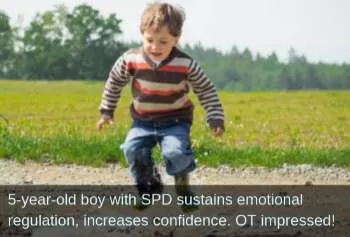Primitive Reflex Integration Case Studies
5-Year-Old Boy with SPD Sustains Emotional Regulation, Increases Confidence. OT Impressed!
Integrating primitive reflexes helps with balance, self-esteem, and more
This young boy with wide-ranging sensory processing issues got relief from tactile sensitivity, improved his balance, and became calmer and more confident after his OT used the primitive reflex integration tools from the Brain and Sensory Foundations, First Level course.
Submitted by T.A. MS, OTR/L Pediatric Occupational Therapist

| Before | After |
|---|---|
| Often disregulated | Better able to sustain or regain regulation |
5 y.o. client with high cognitive functioning presents with SPD: over-responsive to vestibular, tactile, auditory, visual, olfactory and gustatory. Positive for [primitive reflexes unintegrated] Moro [Reflex], ATNR [Asymmetrical Tonic Neck Reflex], STNR [Symmetrical Tonic Reflex], TLR [Tonic Labyrinthine Reflex], Babinksi and Palmar. Started with RM [innate rhythmic movement], FPR [Fear Paralysis Reflex] tapping sequence, and exercises for Babinski and Palmar [Reflex from the Brain and Sensory Foundations, First Level course].
Rapid progress was noted with integration of these reflexes. The first two sessions of FPR tapping he would jump at each tap on his feet and hips, but after that would remain still and reported to enjoy.
Babinski reflex stimulation went from jumping away at stimulus to trace movement of toes and report of “that doesn’t tickle anymore." Even though he is younger than the suggested age for the isometrics, he seemed to really enjoy the hand and foot exercises.
We created a 5 step plan with a challenging exercise (passing a ball overhead between legs). He frequently lost his balance and would become silly/up-regulated. We went through the 5 step balance [process for goal achievement from the Brain and Sensory Foundations program] with the intention to perform 10 times without loss of balance or regulation. After working on prone ball passing and picking up marbles with toes for balance, cross crawls and core activation (he really benefits from the isometric proprioception for regulation), he was then able to meet his goal on the first try! He was really proud—he insisted dad come to the session and record his performance!
Prior to this course, we would focus primarily on providing intense heavy work (proprioception) for self-regulation. I would stimulate his nervous system with vestibular input, and immediately follow up with intense proprioception to help modulate the input. Although this worked, it became evident that the heavy work felt like a ‘consequence’; he would try and say he could “control himself this time” (as though it was a behavioral choice vs. a physical reaction). While taking the course, I started following the vestibular input with RM [innate rhythmic movements] and a form of core activation (where he is in quadruped) instead of harder proprioceptive tasks (e.g. wheelbarrow walks, scooter board ramp).
I was impressed that he was able to sustain or regain regulation and moreover, sustain emotional regulation and confidence in himself—not feeling like his silly/hyperactivity was “bad” and that he needed to “control himself”.
He began to see the follow up/regulation activities as a bonding activity and simply a continuation of play.
He does still occasionally need those more intense proprioceptive activities, but it is nice for therapists and parents to have these additional tools in their toolbox.
[Emphasis Added]
*Disclaimer: The activities in the Brain and Sensory Foundations curriculum make use of the natural processes of neuroplasticity and development that are innately wired in the design of human beings to promote maturity and function. These activities appear to calm, organize, and mature the neuro-sensory-motor systems just as we see in the healthy development of human infants. Individual results may vary, and we do not claim to offer a diagnosis or cure for any specific condition or disorder. The Brain and Sensory Foundations activities appear to improve overall functioning resulting in measurable improvements for a range of conditions as demonstrated in over 1800 case studies from participants.

